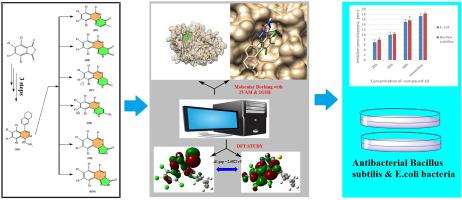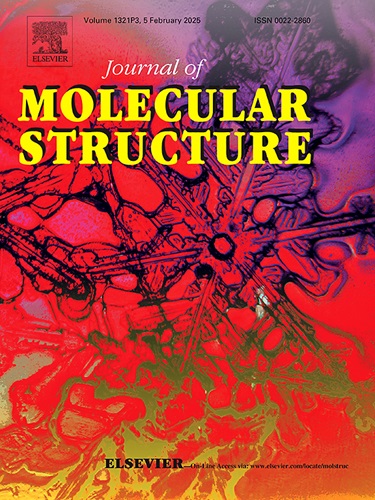Synthesis, design, biological activity, DFT study and molecular docking of new 1,2,4-triazine and 1,2,4-triazol derivatives bearing the phthalazine moiety
IF 4
2区 化学
Q2 CHEMISTRY, PHYSICAL
引用次数: 0
Abstract
The present work aims to synthesise a series of new compounds with a combination of 1,2,4-triazine and 1,2,4-triazole with a phthalazine components that have been created from compound (M4). The structural formula of these new compounds was confirmed by FT-IR, 1HNMR , 13CNMR and Mass spectra. Density functional theory (DFT) simulations utilising the Gausean-9 programme were used to rationalise the mechanism of all novel compounds. They demonstrations that the energy gap between compounds (M8–M10) is 0.09951 a.u., 0.108133 a.u. and 0.9857 a.u., respectively, between HOMO and LOMO. The molecular docking analysis unveiled the existence of several derivatives exhibiting significant binding affinities and unique interaction patterns with the target proteins. Derivatives M8–10 have been identified as the most favourable candidates, demonstrating the highest binding energies and a diverse range of interaction types, such as hydrogen bonding and pi interactions, across various distances. Derivative (M8–10) exhibits the highest binding energy at S = -8.15, -8.18, or -8.28 Kcal/mol with the 2VAM receptor and -8.52, -8.78 and -9.04 Kcal/mol with the 2G1H receptor. The analysis of the inhibition of the growth values in different concentrations against both Escherichia coli and Bacillus subtilis bacteria compared with amoxicillin. The presented research obviously demonstrates that compounds (M8–10) can serve as promising candidates for alternatives to new medications. The empirical findings were consistent with the anticipated outcomes derived from the molecular docking analysis.

含有酞嗪分子的 1,2,4- 三嗪和 1,2,4- 三唑新衍生物的合成、设计、生物活性、DFT 研究和分子对接
本研究旨在合成一系列新化合物,这些化合物由 1,2,4-三嗪和 1,2,4-三唑与酞嗪成分组合而成,由化合物 (M4) 制成。傅立叶变换红外光谱、1HNMR、13CNMR 和质谱证实了这些新化合物的结构式。利用 Gausean-9 程序进行的密度泛函理论(DFT)模拟使所有新型化合物的机理更加合理。结果表明,化合物(M8-M10)的 HOMO 和 LOMO 之间的能隙分别为 0.09951 a.u.、0.108133 a.u. 和 0.9857 a.u.。分子对接分析揭示了几种衍生物与目标蛋白质之间具有显著的结合亲和力和独特的相互作用模式。衍生物 M8-10 被确定为最有利的候选化合物,它们表现出最高的结合能和不同距离的多种相互作用类型,如氢键和 pi 相互作用。衍生物(M8-10)与 2VAM 受体的结合能最高,分别为 S = -8.15、-8.18 或 -8.28千卡/摩尔;与 2G1H 受体的结合能分别为 -8.52、-8.78 和 -9.04 千卡/摩尔。与阿莫西林相比,不同浓度的化合物对大肠杆菌和枯草芽孢杆菌的生长抑制值分析。所提交的研究结果明显表明,化合物(M8-10)可作为新药物的候选替代品。实验结果与分子对接分析得出的预期结果一致。
本文章由计算机程序翻译,如有差异,请以英文原文为准。
求助全文
约1分钟内获得全文
求助全文
来源期刊

Journal of Molecular Structure
化学-物理化学
CiteScore
7.10
自引率
15.80%
发文量
2384
审稿时长
45 days
期刊介绍:
The Journal of Molecular Structure is dedicated to the publication of full-length articles and review papers, providing important new structural information on all types of chemical species including:
• Stable and unstable molecules in all types of environments (vapour, molecular beam, liquid, solution, liquid crystal, solid state, matrix-isolated, surface-absorbed etc.)
• Chemical intermediates
• Molecules in excited states
• Biological molecules
• Polymers.
The methods used may include any combination of spectroscopic and non-spectroscopic techniques, for example:
• Infrared spectroscopy (mid, far, near)
• Raman spectroscopy and non-linear Raman methods (CARS, etc.)
• Electronic absorption spectroscopy
• Optical rotatory dispersion and circular dichroism
• Fluorescence and phosphorescence techniques
• Electron spectroscopies (PES, XPS), EXAFS, etc.
• Microwave spectroscopy
• Electron diffraction
• NMR and ESR spectroscopies
• Mössbauer spectroscopy
• X-ray crystallography
• Charge Density Analyses
• Computational Studies (supplementing experimental methods)
We encourage publications combining theoretical and experimental approaches. The structural insights gained by the studies should be correlated with the properties, activity and/ or reactivity of the molecule under investigation and the relevance of this molecule and its implications should be discussed.
 求助内容:
求助内容: 应助结果提醒方式:
应助结果提醒方式:


